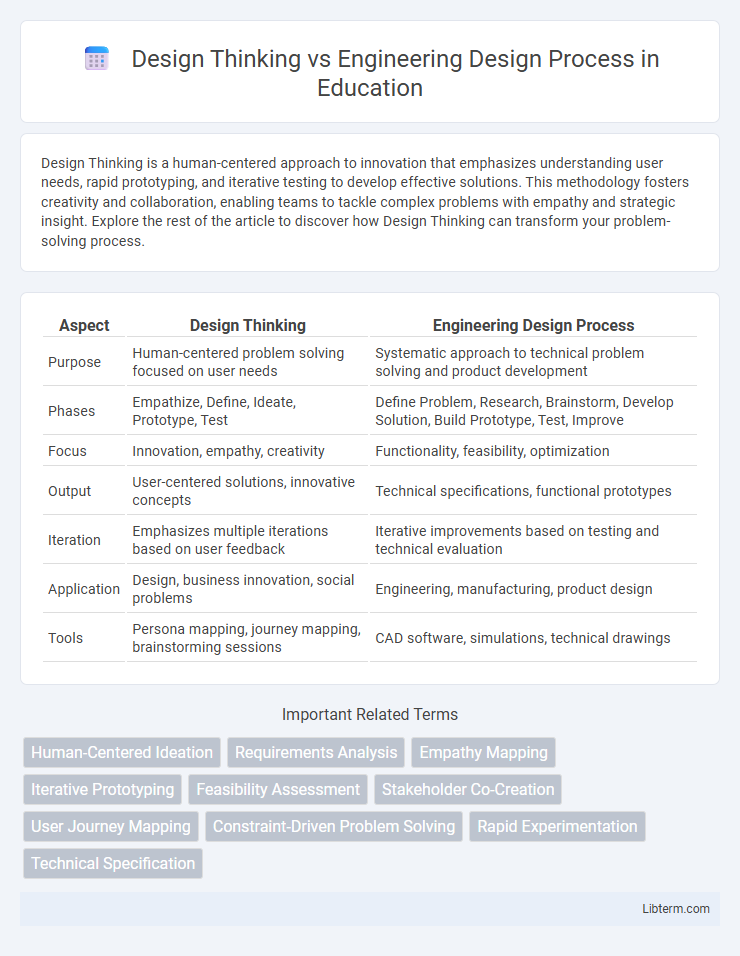Design Thinking is a human-centered approach to innovation that emphasizes understanding user needs, rapid prototyping, and iterative testing to develop effective solutions. This methodology fosters creativity and collaboration, enabling teams to tackle complex problems with empathy and strategic insight. Explore the rest of the article to discover how Design Thinking can transform your problem-solving process.
Table of Comparison
| Aspect | Design Thinking | Engineering Design Process |
|---|---|---|
| Purpose | Human-centered problem solving focused on user needs | Systematic approach to technical problem solving and product development |
| Phases | Empathize, Define, Ideate, Prototype, Test | Define Problem, Research, Brainstorm, Develop Solution, Build Prototype, Test, Improve |
| Focus | Innovation, empathy, creativity | Functionality, feasibility, optimization |
| Output | User-centered solutions, innovative concepts | Technical specifications, functional prototypes |
| Iteration | Emphasizes multiple iterations based on user feedback | Iterative improvements based on testing and technical evaluation |
| Application | Design, business innovation, social problems | Engineering, manufacturing, product design |
| Tools | Persona mapping, journey mapping, brainstorming sessions | CAD software, simulations, technical drawings |
Introduction to Design Thinking and Engineering Design Process
Design Thinking emphasizes human-centered problem solving through empathy, ideation, and iterative prototyping to create innovative solutions tailored to user needs. The Engineering Design Process follows a systematic approach involving defining problems, researching, brainstorming, designing, testing, and refining technical solutions to meet specific engineering requirements. Both methodologies drive creativity and efficiency but differ in focus: Design Thinking prioritizes user experience while Engineering Design Process centers on technical feasibility and functionality.
Key Principles of Design Thinking
Design Thinking centers on user empathy, iterative prototyping, and collaborative problem-solving to create human-centered solutions. It emphasizes understanding user needs deeply through observation and feedback, encouraging divergent thinking to explore multiple ideas before converging on optimal solutions. This approach contrasts with the Engineering Design Process, which prioritizes systematic analysis, technical specifications, and testing to refine designs toward functional and feasible outcomes.
Core Elements of the Engineering Design Process
The Engineering Design Process centers on core elements such as problem identification, research, concept development, prototyping, testing, and iteration to create practical, functional solutions. This method emphasizes technical feasibility, optimization, and constraints like cost and materials, contrasting with Design Thinking's human-centered approach. Effective engineering design relies heavily on systematic analysis and refinement to meet specific performance criteria and engineering standards.
Human-Centered vs Problem-Centered Approaches
Design Thinking emphasizes a human-centered approach, prioritizing empathy and user needs to foster innovative solutions that enhance user experience. In contrast, the Engineering Design Process is problem-centered, focusing on systematically defining and solving technical challenges through structured analysis and optimization. Both methodologies integrate iterative testing and refinement but differ fundamentally in their initial focus--users versus problems.
Stages of Design Thinking Compared to Engineering Design
Design Thinking consists of five key stages: Empathize, Define, Ideate, Prototype, and Test, emphasizing user-centered innovation and iterative problem-solving. The Engineering Design Process typically involves defining the problem, researching, specifying requirements, brainstorming solutions, developing and prototyping, testing, and refining, focusing on technical feasibility and optimization. Both processes share iterative prototyping and testing phases but differ in their approach to problem framing and user involvement, with Design Thinking prioritizing empathy and human-centric solutions.
Applications in Industry and Education
Design Thinking emphasizes user-centered innovation and iterative prototyping widely applied in industries like software development, product design, and healthcare to solve complex, ambiguous problems by prioritizing empathy and creativity. The Engineering Design Process involves systematic problem-solving steps such as defining requirements, conceptualizing solutions, and optimizing designs, frequently used in manufacturing, civil engineering, and aerospace sectors to ensure feasibility, functionality, and efficiency. In education, Design Thinking fosters creativity and collaboration skills across disciplines, while the Engineering Design Process develops critical analytical and technical competencies in STEM-focused curricula.
Advantages and Limitations of Each Approach
Design Thinking fosters creativity and user-centered innovation by emphasizing empathy, ideation, and prototyping, making it highly effective for solving ambiguous or complex problems but can lack structure and ignore technical constraints. The Engineering Design Process provides a systematic, logical approach focusing on feasibility, optimization, and technical requirements, which ensures practical and functional solutions but may limit creativity and adaptability to changing user needs. Balancing these approaches can maximize innovation while maintaining technical rigor and real-world applicability.
Integration and Hybrid Models
Design Thinking emphasizes empathy, ideation, and user-centric solutions, while the Engineering Design Process prioritizes systematic problem-solving and technical feasibility. Integration of these methodologies creates hybrid models that leverage creativity alongside analytical rigor, fostering innovative solutions grounded in real-world constraints. Hybrid approaches enhance collaboration across disciplines, optimizing both user experience and functional performance.
Real-World Case Studies and Examples
Design Thinking emphasizes human-centered problem-solving, leveraging empathy and iterative prototyping as seen in IDEO's redesign of the shopping cart, which prioritized user experience and safety. The Engineering Design Process focuses on systematic technical analysis and optimization, exemplified by SpaceX's development of reusable rockets, where rigorous testing and engineering principles were crucial. Real-world applications highlight that Design Thinking excels in addressing user needs and creativity, while the Engineering Design Process ensures functional feasibility and technical precision.
Choosing the Right Approach for Your Project
Choosing the right approach between Design Thinking and the Engineering Design Process depends on project goals and context. Design Thinking excels in human-centered innovation, emphasizing empathy, ideation, and iterative prototyping to solve complex problems. The Engineering Design Process prioritizes technical feasibility, systematic analysis, and detailed planning, making it ideal for projects requiring precision and optimization.
Design Thinking Infographic

 libterm.com
libterm.com